Ecohydrologic Connections in Semiarid Watershed Systems of Central Oregon USA
Abstract
:1. Introduction
2. Materials and Methods
2.1. Description of Study Area
2.2. Field Data Collection
2.2.1. Soil Physical Properties
2.2.2. Precipitation Interception and Soil Moisture Content—Plot scale
- I = Average precipitation interception in each plot;
- IUC = Precipitation interception at under-canopy locations;
- IDL = Precipitation interception at drip line locations;
- IIC = Precipitation interception at inter-canopy locations;
- n = number of rain gauges in each plot.
2.2.3. Surface Water and Groundwater Relations—Watershed Scale
3. Results
3.1. Precipitation Interception and Soil Moisture Variability—Plot Scale
3.1.1. Canopy Cover and Precipitation Interception
3.1.2. Soil Moisture—Plot Scale
3.2. Surface Water and Groundwater Relations—Watershed Scale
3.2.1. Precipitation and Streamflow
3.2.2. Precipitation and Springflow
3.2.3. Soil Moisture and Shallow Groundwater Level Fluctuations
4. Discussion
Acknowledgments
Author Contributions
Conflicts of Interest
Appendix A
Soil Physical Properties
| Soil Depth | Bulk Density | Sand | Silt | Clay |
|---|---|---|---|---|
| (Mg m−³) | (%) | (%) | (%) | |
| (a) Mays WS | ||||
| 0.2 m | 1.51 ± 0.001 | 67.5 ± 1.93 | 11.2 ± 0.94 | 21.3 ± 0.99 |
| 0.5 m | 1.60 ± 0.04 | 69.6 ± 0.00 | 9.2 ± 0.00 | 21.2 ± 0.00 |
| 0.8 m | 1.55 ± 0.02 | 68.9 ± 0.54 | 9.9 ± 0.27 | 21.2 ± 0.47 |
| (b) Jensen WS | ||||
| Upstream—Under-canopy | ||||
| 0.2 m | 1.18 ± 0.04 | 59.1 ± 1.46 | 11.7 ± 0.24 | 29.3 ± 1.23 |
| 0.5 m | 1.36 ± 0.03 | 62.4 ± 0.98 | 11.3 ± 0.85 | 26.3 ± 0.88 |
| 0.8 m | 1.53 ± 0.06 | 60.5 ± 0.44 | 12.9 ± 0.54 | 26.5 ± 0.85 |
| Upstream—Inter-canopy | ||||
| 0.2 m | 1.29 ± 0.02 | 65.2 ± 1.15 | 13.6 ± 0.50 | 21.2 ± 1.54 |
| 0.5 m | 1.46 ± 0.04 | 62.7 ± 0.54 | 14.8 ± 0.50 | 22.5 ± 0.61 |
| 0.8 m | 1.57 ± 0.01 | 62.0 ± 0.00 | 16.4 ± 0.00 | 21.6 ± 0.00 |
| Downstream—Under-canopy | ||||
| 0.2 m | N/A | 81.1 ± 1.44 | 16.5 ± 0.99 | 2.5 ± 0.52 |
| 0.5 m | N/A | 74.4 ± 0.94 | 15.5 ± 1.29 | 10.1 ± 0.77 |
| 0.8 m | N/A | 75.7 ± 1.09 | 16.1 ± 0.72 | 8.2 ± 1.70 |
| Downstream—Inter-canopy | ||||
| 0.2 m | N/A | 78.4 ± 0.94 | 15.4 ± 1.25 | 6.2 ± 2.16 |
| 0.5 m | N/A | 79.1 ± 2.18 | 14.1 ± 1.91 | 6.9 ± 0.27 |
| 0.8 m | N/A | 79.1 ± 2.37 | 12.1 ± 1.36 | 8.9 ± 1.52 |
| (c) Riparian Valley | ||||
| 0.2 m | 0.93 ± 0.04 | 24.4 ± 5.95 | 59.8 ± 1.73 | 15.8 ± 4.33 |
| 0.5 m | 1.00 ± 0.04 | 19.2 ± 3.46 | 57.1 ± 3.05 | 23.7 ± 2.57 |
| 0.8 m | 0.97 ± 0.01 | 34.7 ± 0.054 | 20.9 ± 2.25 | 44.4 ± 2.66 |
References
- Hoffman, M.T.; Cowling, M. Vegetation change in the semi-arid Karoo over the last 200 years: An expanding Karoo—Fact or fiction. S. Afr. J. Sci. 1990, 86, 286–294. [Google Scholar]
- Puttock, A.; Dungait, J.A.J.; Macleod, C.J.A.; Bol, R.; Brazier, R.E. Woody plant encroachment into grasslands leads to accelerated erosion of previously stable organic carbon from dryland soils. J. Geophys. Res. Biogeosci. 2014, 119, 2345–2357. [Google Scholar] [CrossRef] [Green Version]
- Scholes, R.J.; Archer, S.R. Tree-Grass Interactions in Savannas. Annu. Rev. Ecol. Syst. 1997, 28, 517–544. [Google Scholar] [CrossRef]
- Ratajczak, Z.; Nippert, J.B.; Collins, S.L. Woody encroachment decreases diversity across North American grasslands and savannas. Ecology 2012, 93, 697–703. [Google Scholar] [CrossRef] [PubMed]
- Millennium Ecosystem Assessment. Ecosystems and Human Well-Being: Desertification Synthesis; World Resources Institute: Washington, DC, USA, 2005. [Google Scholar]
- Intergovernmental Panel on Climate Change (IPCC). Climate Change 2014: Synthesis Report; Contribution of Working Groups I, II and III to the Fifth Assessment Report of the Intergovernmental Panel on Climate Change; Core Writing Team, Pachauri, R.K., Meyer, L.A., Eds.; IPCC: Geneva, Switzerland, 2014; 151p. [Google Scholar]
- Romme, W.H.; Allen, C.D.; Bailey, J.D.; Baker, W.L.; Bestelmeyer, B.T.; Brown, P.M.; Eisenhart, K.S.; Floyd, M.L.; Huffman, D.W.; Jacobs, B.F.; et al. Historical and modern disturbance regimes, stand structures, and landscape dynamics in piñon–juniper vegetation of the Western United States. Rangel. Ecol. Manag. 2009, 62, 203–222. [Google Scholar] [CrossRef]
- Miller, R.F.; Bates, J.D.; Svejcar, T.J.; Pierson, F.B.; Eddleman, L.E. Biology, Ecology, and Management of Western Juniper (Juniperus occidentalis); Technical Bulletin; Agricultural Experiment Station, Oregon State University: Corvallis, OR, USA, 2005; Volume 152. [Google Scholar]
- Miller, R.F.; Tausch, R.J. The role of fire in juniper and pinyon woodlands: A descriptive analysis. In Proceedings of the Invasive Species Workshop: The Role of Fire in the Control and Spread of Invasive Species. Held at Fire Conference 2000: The First National Congress on Fire Ecology, Prevention, and Management; Misc. Pub. 11; Galley, K.E.M., Wilson, T.P., Eds.; Tall Timbers Research Station: Tallahassee, FL, USA, 2001. [Google Scholar]
- Cowlin, R.W.; Briegleb, P.A.; Moravets, F.L. Forest Resources of the Ponderosa Pine Region of Washington and Oregon; U.S. Department of Agriculture, Forest Service: Washington, DC, USA, 1942.
- Azuma, D.L.; Hiserote, B.A.; Dunham, P.A. The Western Juniper Resource of Eastern Oregon; Resources Bulletin, PNW-RB-249; USDA, Forest Service, Pacific Northwest Research Station: Portland, OR, USA, 2005; 18p.
- Burns, R.M.; Honkala, B.H. Tech. Coords. Silvics of North America: 1. Conifers; 2. Hardwoods. In Agriculture Handbook 654; U.S. Department of Agriculture, Forest Service: Washington, DC, USA, 1990; Volume 2, p. 877. [Google Scholar]
- Gedney, D.R.; Azuma, D.L.; Bolsinger, C.L.; McKay, N. Western Juniper in Eastern Oregon; Gen. Tech. Rep. PNW-GTR-464; U.S. Department of Agriculture, Forest Service, Pacific Northwest Research Station: Portland, OR, USA, 1999; 53p.
- Chambers, J.C. Pinus monophylla establishment in an expanding Pinus-Juniperus woodland: Environmental conditions, facilitation and interacting factors. J. Veg. Sci. 2001, 12, 27–40. [Google Scholar] [CrossRef]
- Coppedge, B.R.; Engle, D.M.; Masters, R.E.; Gregory, M.S. Predicting juniper encroachment and CRP effects on avian community dynamics in southern mixed-grass prairie, USA. Biol. Conserv. 2004, 115, 431–441. [Google Scholar] [CrossRef]
- Taylor, C.A. Role of summer prescribed fire to manage shrub-invaded grasslands. In Proceedings of the Shrubland Dynamics—Fire and Water, Lubbock, TX, USA, 10–12 August 2004; RMRS-P-47; Sosebee, R.E., Wester, D.B., Britton, C.M., McArthur, E.D., Kitchen, S.G., Eds.; US Department of Agriculture, Forest Service: Fort Collins, CO, USA, 2007; pp. 52–55. [Google Scholar]
- Gottfried, G.J.; Pieper, R.D. Pinyon-juniper rangelands. In Livestock Management in the American Southwest: Ecology, Society, and Economics; Jemison, R., Raish, C., Eds.; Elsevier: New York, NY, USA, 2000; pp. 153–212. [Google Scholar]
- McPherson, G.R.; Wright, H.A. Effects of cattle grazing and juniperus pinchotii canopy cover on herb cover and production in western Texas. Am. Midl. Nat. 1990, 123, 144–151. [Google Scholar] [CrossRef]
- Vaitkus, M.R.; Eddleman, L.E. Composition and Productivity of a Western Juniper Understory and Its Response to Canopy Removal. In Proceedings—Pinyon-Juniper Conference; USDA-Forest Service Gen. Tech. Rep. INT-215; Everett, R.L., Ed.; Intermountain Research Station: Ogden, UT, USA, 1987; pp. 456–460. [Google Scholar]
- Tausch, R.J.; West, N.E. Plant species composition patterns with differences in tree dominance on a southwestern Utah pinyon-juniper site. In Desired Future Conditions for Pinyon-Juniper Ecosystems; Gen. Tech. Rep. RM-GTR-258; US Department of Agriculture, Forest Service: Flagstaff, AZ, USA, 1995; pp. 16–23. [Google Scholar]
- Miller, R.F.; Svejcar, T.J.; Rose, J.A. Impacts of western juniper on plant community composition and structure. J. Range Manag. 2000, 53, 574–585. [Google Scholar] [CrossRef]
- Bates, J.D.; Miller, R.F.; Svejcar, T. Long-term successional trends following western juniper Cutting. Rangel. Ecol. Manag. 2005, 58, 533–541. [Google Scholar] [CrossRef]
- Bates, J.D.; Svejcar, T.J.; Miller, R.F. Effects of juniper cutting on nitrogen mineralization. J. Arid Environ. 2002, 51, 221–234. [Google Scholar] [CrossRef]
- Mollnau, C.; Newton, M.; Stringham, T. Soil water dynamics and water use in a western juniper (Juniperus occidentalis) woodland. J. Arid Environ. 2014, 102, 117–126. [Google Scholar] [CrossRef]
- Petersen, S.L.; Stringham, T.K. Infiltration, runoff, and sediment yield in response to western juniper encroachment in Southeast Oregon. Rangel. Ecol. Manag. 2008, 61, 74–81. [Google Scholar] [CrossRef]
- Wilcox, B.P. Runoff and erosion in intercanopy zones of pinyon-juniper woodlands. J. Range Manag. 1994, 47, 285–295. [Google Scholar] [CrossRef]
- Pierson, F.B.; Williams, C.J.; Kormos, P.R.; Al-Hamdan, O.Z. Short-term effects of tree removal on infiltration, runoff, and erosion in woodland-encroached sagebrush steppe. Rangel. Ecol. Manag. 2014, 67, 522–538. [Google Scholar] [CrossRef]
- Cline, N.L.; Roundy, B.A.; Pierson, F.B.; Kormos, P.; Williams, C.J. Hydrologic Response to Mechanical Shredding in a Juniper Woodland. Rangel. Ecol. Manag. 2010, 63, 467–477. [Google Scholar] [CrossRef]
- Allen, C.D. Ecohydrology of pinon-juniper woodlands in the Jemez Mountains, New Mexico: Runoff, erosion, and restoration. In Ecology, Management, and Restoration of Piñon-Juniper and Ponderosa Pine Ecosystems; U.S. Department of Agriculture, Forest Service, Rocky Mountain Research Station: Fort Collins, CO, USA, 2008; pp. 65–66. [Google Scholar]
- Hibbert, A.R. Water yield improvement potential by vegetation management on western rangelands. J. Am. Water Resour. Assoc. 1983, 19, 375–381. [Google Scholar] [CrossRef]
- Ffolliott, P.F.; Gottfried, G.J. Hydrological Processes in the Pinyon-Juniper Woodlands: A Literature Review; General Technical Report RMRS GTR-271; US Department of Agriculture, Forest Service, Rocky Mountain Research Station: Fort Collins, CO, USA, 2012.
- Kuhn, T.; Cao, D.; George, M. Juniper removal may not increase overall Klamath River Basin water yileds. Calif. Agric. 2007, 61, 166–171. [Google Scholar] [CrossRef]
- Barlow, P.M.; Leake, S.A. Streamflow Depletion by Wells—Understanding and Managing the Effects of Groundwater Pumping on Streamflow; U.S. Geological Survey Circular 1376; Department of the Interior, U.S. Geological Survey: Reston, VA, USA, 2012; 84p.
- Taylor, R.G.; Scanlon, B.; Döll, P.; Rodell, M.; van Beek, R.; Wada, Y.; Longuevergne, L.; Leblanc, M.; Famiglietti, J.S.; Edmunds, M.; et al. Ground water and climate change. Nat. Clim. Chang. 2013, 3, 322–329. [Google Scholar] [CrossRef] [Green Version]
- Sophocleous, M. Interactions between groundwater and surface water: The state of the science. Hydrogeol. J. 2002, 10, 52–67. [Google Scholar] [CrossRef]
- Detty, J.M.; McGuire, K.J. Topographic controls on shallow groundwater dynamics: Implications of hydrologic connectivity between hillslopes and riparian zones in a till mantled catchment. Hydrol. Process. 2010, 24, 2222–2236. [Google Scholar] [CrossRef]
- Devito, K.; Creed, I.; Gan, T.; Mendoza, C.; Petrone, R.; Silins, U.; Smerdon, B. A framework for broad-scale classification of hydrologic response units on the Boreal Plain: Is topography the last thing to consider? Hydrol. Process. 2005, 19, 1705–1714. [Google Scholar] [CrossRef]
- Jencso, K.G.; McGlynn, B.L.; Gooseff, M.N.; Wondzell, S.M.; Bencala, K.E.; Marshall, L.A. Hydrologic connectivity between landscapes and streams: Transferring reach- and plot-scale understanding to the catchment scale. Water Resour. Res. 2009, 45. [Google Scholar] [CrossRef]
- Ocampo, C.J.; Sivapalan, M.; Oldham, C. Hydrological connectivity of upland-riparian zones in agricultural catchments: Implications for runoff generation and nitrate transport. J. Hydrol. 2006, 331, 643–658. [Google Scholar] [CrossRef]
- Ochoa, C.G.; Guldan, S.J.; Cibils, A.F.; Lopez, S.C.; Boykin, K.G.; Tidwell, V.C.; Fernald, A.G. Hydrologic connectivity of head waters and floodplains in a semiarid watershed. J. Contemp. Water Res. Educ. 2013, 152, 69–78. [Google Scholar] [CrossRef]
- Albertson, J.D.; Kiely, G. On the structure of soil moisture time series in the context of land surface models. J. Hydrol. 2001, 243, 101–119. [Google Scholar] [CrossRef]
- Emanuel, R.E.; Hazen, A.G.; Mcglynn, B.L.; Jencso, K.G. Vegetation and topographic influences on the connectivity of shallow groundwater between hillslopes and streams. Ecohydrology 2013, 7, 887–895. [Google Scholar] [CrossRef]
- Jencso, K.G.; McGlynn, B.L. Hierarchical controls on runoff generation: Topographically driven hydrologic connectivity, geology, and vegetation. Water Resour. Res. 2011, 47. [Google Scholar] [CrossRef]
- Miller, R.F.; Chambers, J.C.; Pyke, D.A.; Pierson, F.B.; Williams, C.J. A Review of Fire Effects on Vegetation and Soils in the Great Basin Region: Response and Ecological Site Characteristics; Gen. Tech. Rep. RMRS-GTR-308; U.S. Department of Agriculture, Forest Service, Rocky Mountain Research Station: Fort Collins, CO, USA, 2013.
- Deboodt, T.L. Watershed Response to Western Juniper Control. Ph.D. Thesis, Oregon State University, Corvallis, OR, USA, 2008. [Google Scholar]
- Ray, G. Long-Term Ecohydrologic Response to Western Juniper (Juniperus occidentalis) Control in Semiarid Watersheds of Central Oregon: A Paired Watershed Study. Master’s Thesis, Oregon State University, Corvallis, OR, USA, 2015. [Google Scholar]
- Fisher, M.P. Analysis of Hydrology and Erosion in Small, Paired Watersheds in a Juniper-Sagebrush Area of Central Oregon. Ph.D. Thesis, Oregon State University, Corvallis, OR, USA, 2004. [Google Scholar]
- Cooperative Climatological Data Summaries, Western Regional Climate Center. Available online: http://www.wrcc.dri.edu/cgi-bin/cliMAIN.pl?or0501 (accessed on 25 November 2017).
- Soil Survey Staff Natural Resources Conservation Service, United States Department of Agriculture. Official Soil Series Descriptions. Available online: https://www.nrcs.usda.gov/wps/portal/nrcs/detail/soils/home/?cid=nrcs142p2_053587 (accessed on 24 December 2017).
- Gee, G.W.; Bauder, J.W. Particle-size analysis. In Methods of Soil Analysis. Part 1; ASA and SSSA: Madison, WI, USA, 1986; pp. 383–411. [Google Scholar]
- Blake, G.R.; Hartge, K.H. Bulk density. In Methods of Soil Analysis. Part 1; ASA and SSSA: Madison, WI, USA, 1986; pp. 363–375. [Google Scholar]
- Strickler, G.S. Use of the Densiometer to Estimate Density of Forest Canopy on Permanent Sample Plots; PNW Old Series Research Notes No. 180; U.S. Department of Agriculture, Forest Service, Pacific Northwest Forest and Range Experiment Station: Portland, OR, USA, 1959; pp. 1–5.
- Kilpatrick, F.; Schneider, V. Use of flumes in measuring discharge. In US Geological Survey Techniques and Methods, Book 3; U.S. Department of the Interior, Geological Survey: Reston, VA, USA, 1983; pp. 21–26. [Google Scholar]
- Young, J.A.; Evans, R.A.; Easi, D.A. Stem flow on western juniper (Juniperus occidentalis) trees. Weed Sci. 1984, 32, 320–327. [Google Scholar]
- Larsen, R.E. Interception and Water Holding Capacity of Western Juniper. Ph.D. Thesis, Oregon State University, Corvallis, OR, USA, 1993. [Google Scholar]
- Niemeyer, R.J.; Link, T.E.; Seyfried, M.S.; Flerchinger, G.N. Surface water input from snowmelt and rain throughfall in western juniper: Potential impacts of climate change and shifts in semi-arid vegetation. Hydrol. Process. 2016, 30, 3046–3060. [Google Scholar] [CrossRef]
- Caruso, P. Hydrogeologic Framework of an Area of Interest in the Southeast Deschutes Basin Oregon, USA. In Hydrogeology and Hydrologic Connectivity of a Semiarid Central Oregon Rangeland System. Master’s Thesis, Oregon State University, Corvallis, OR, USA, 2017. [Google Scholar]
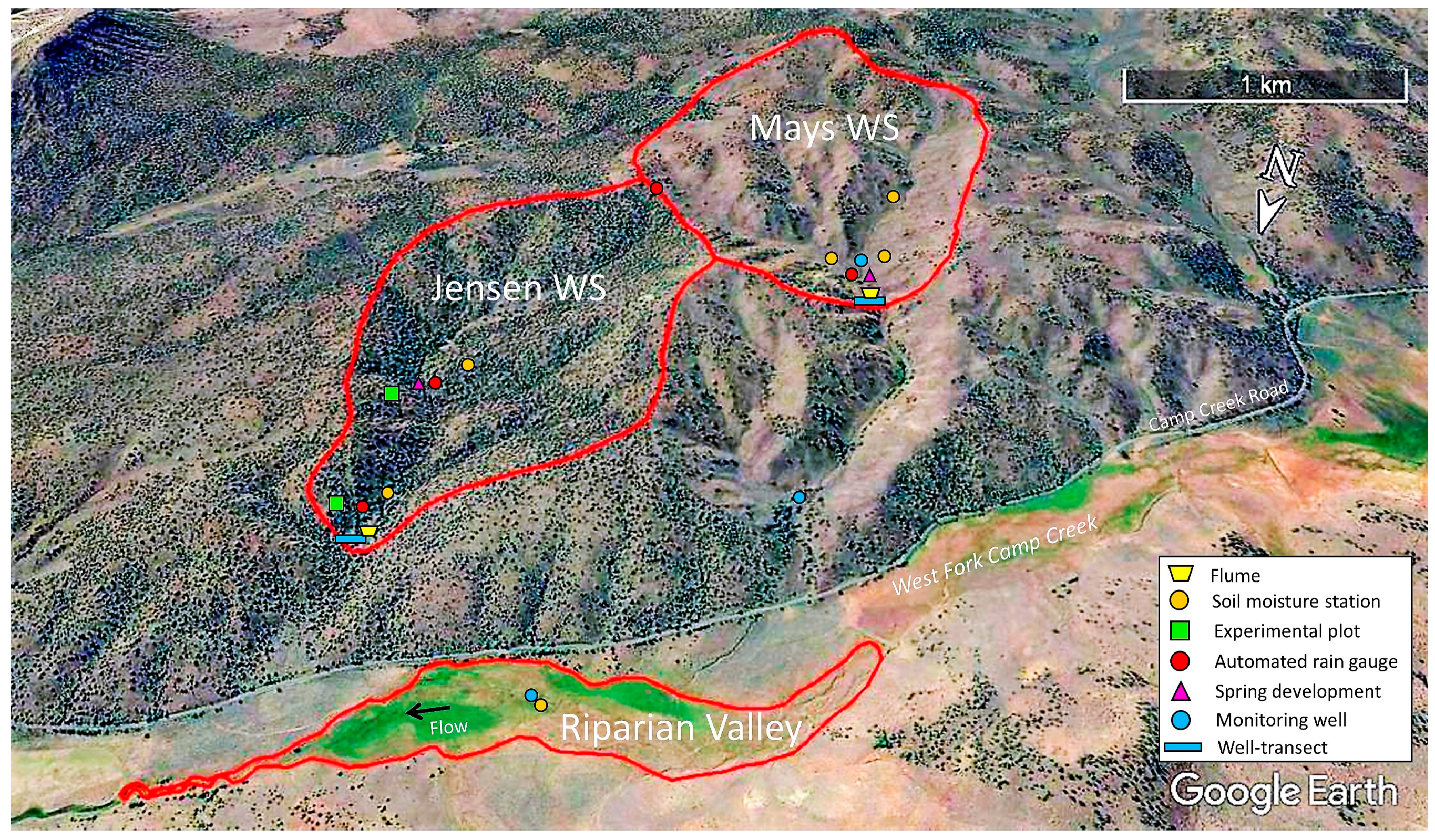
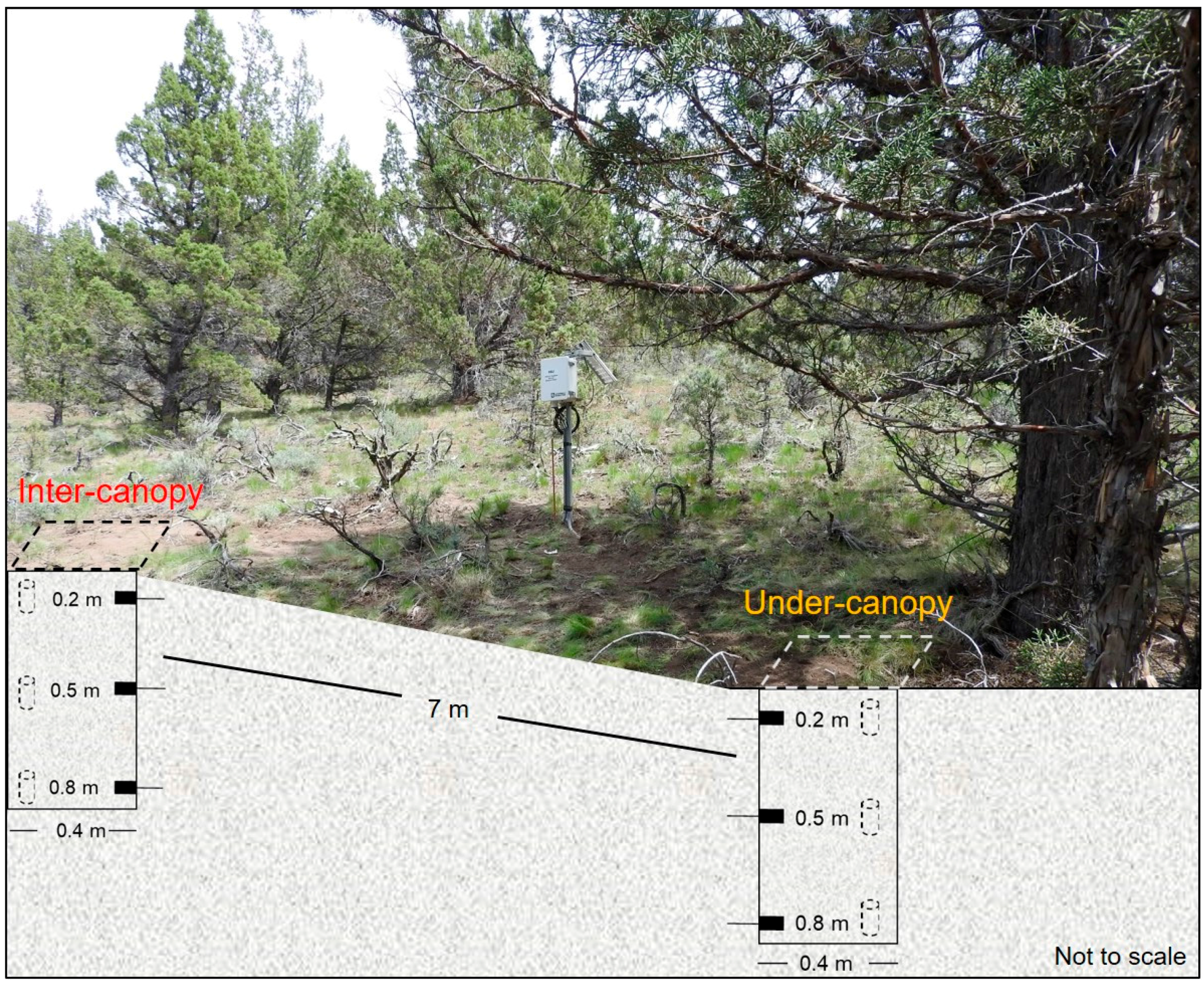

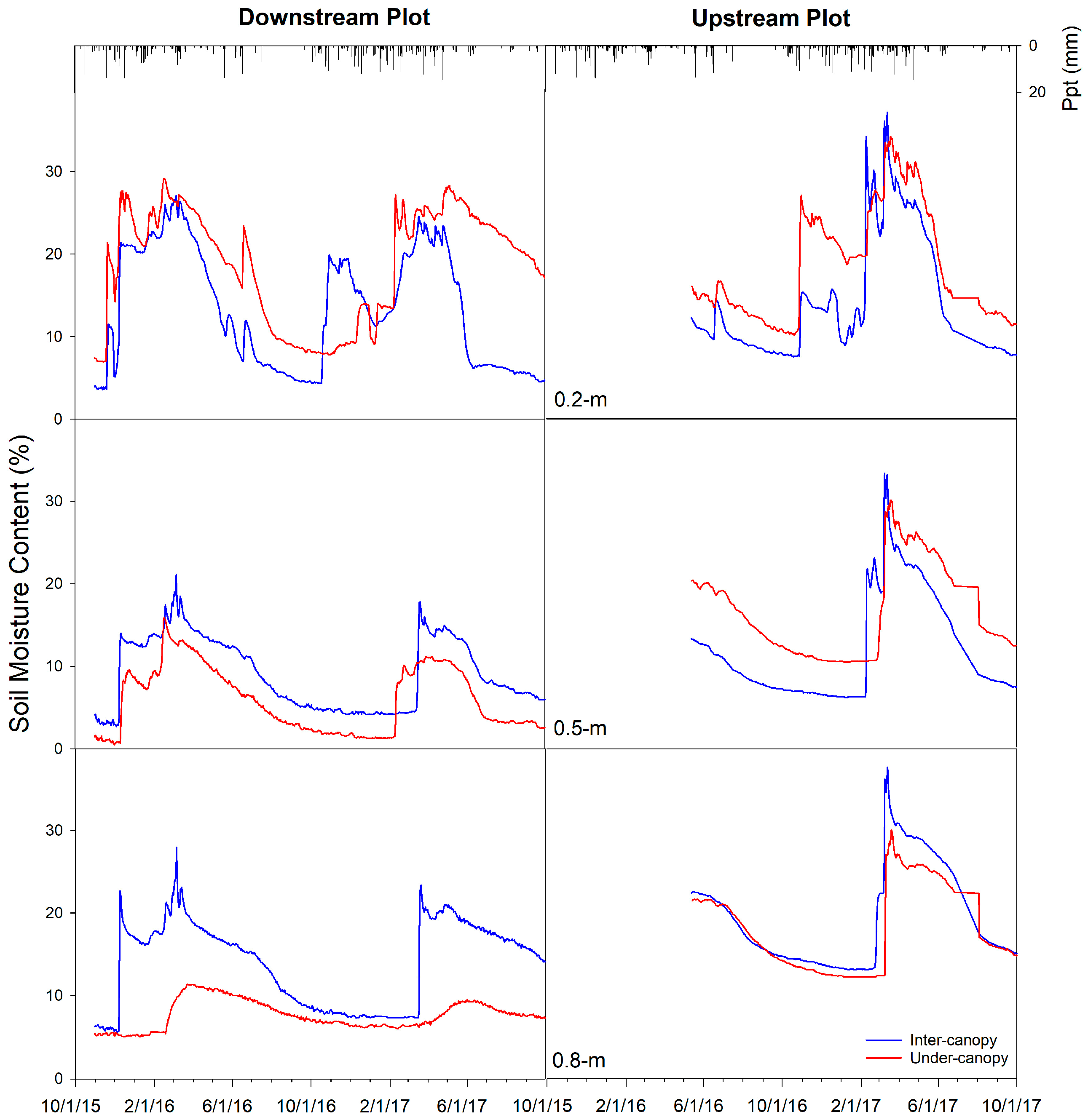
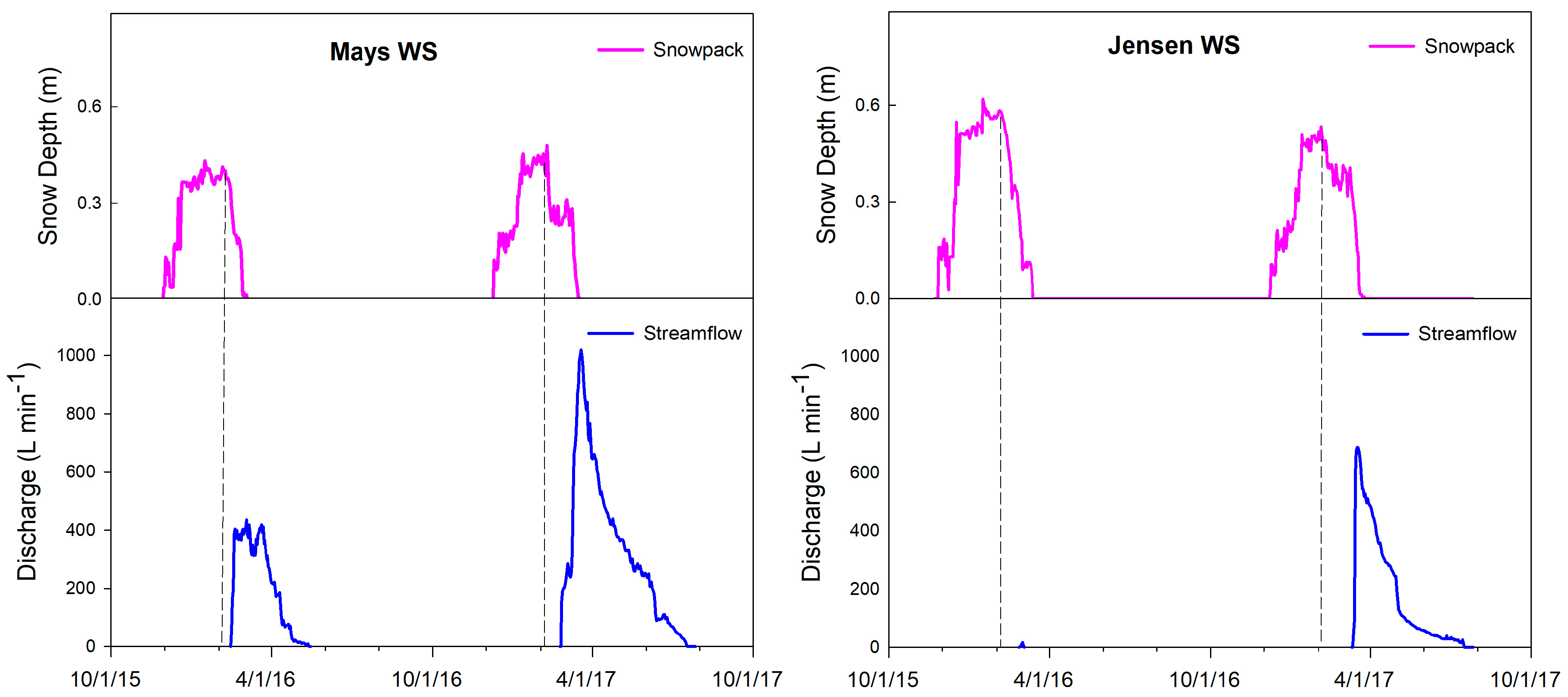
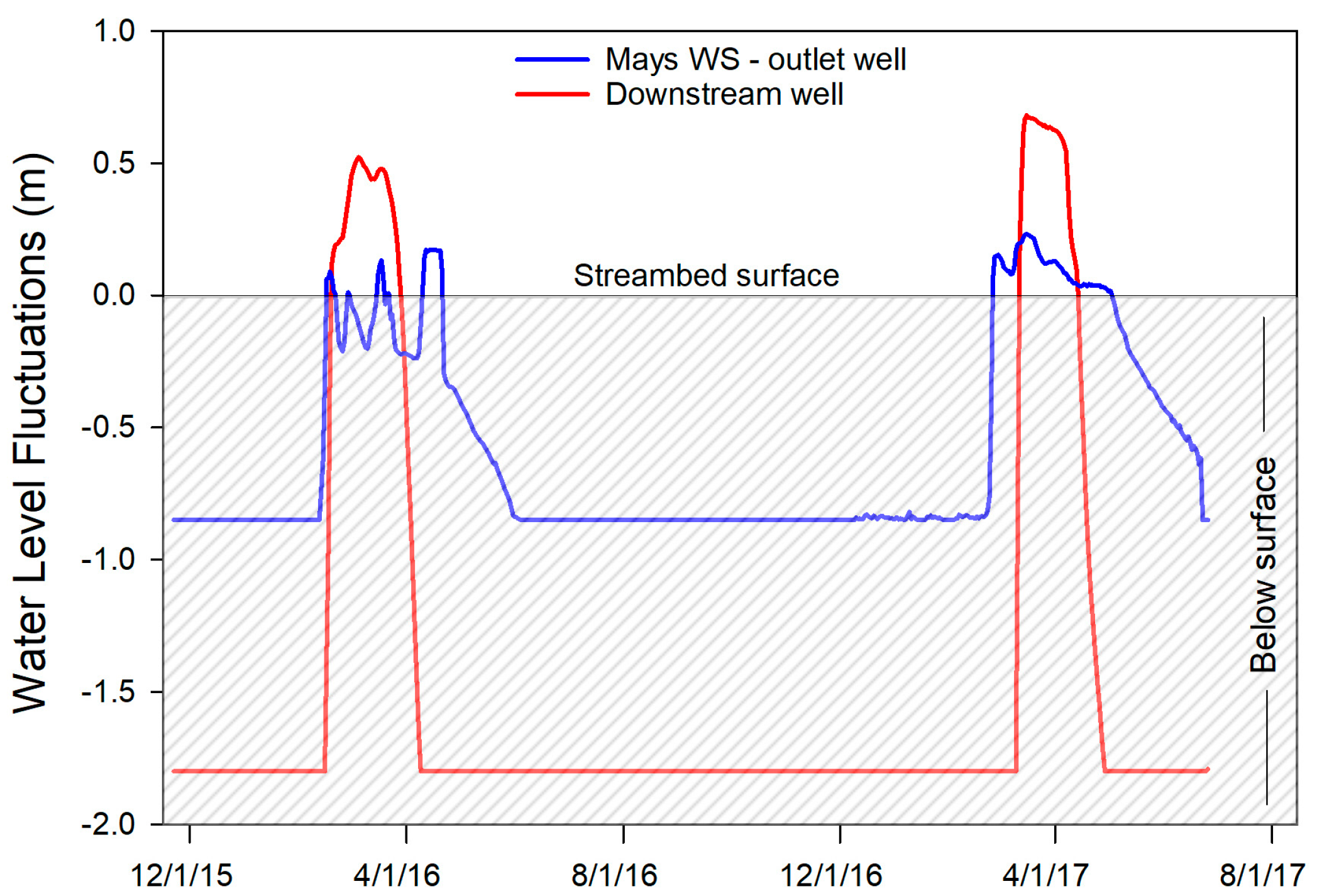

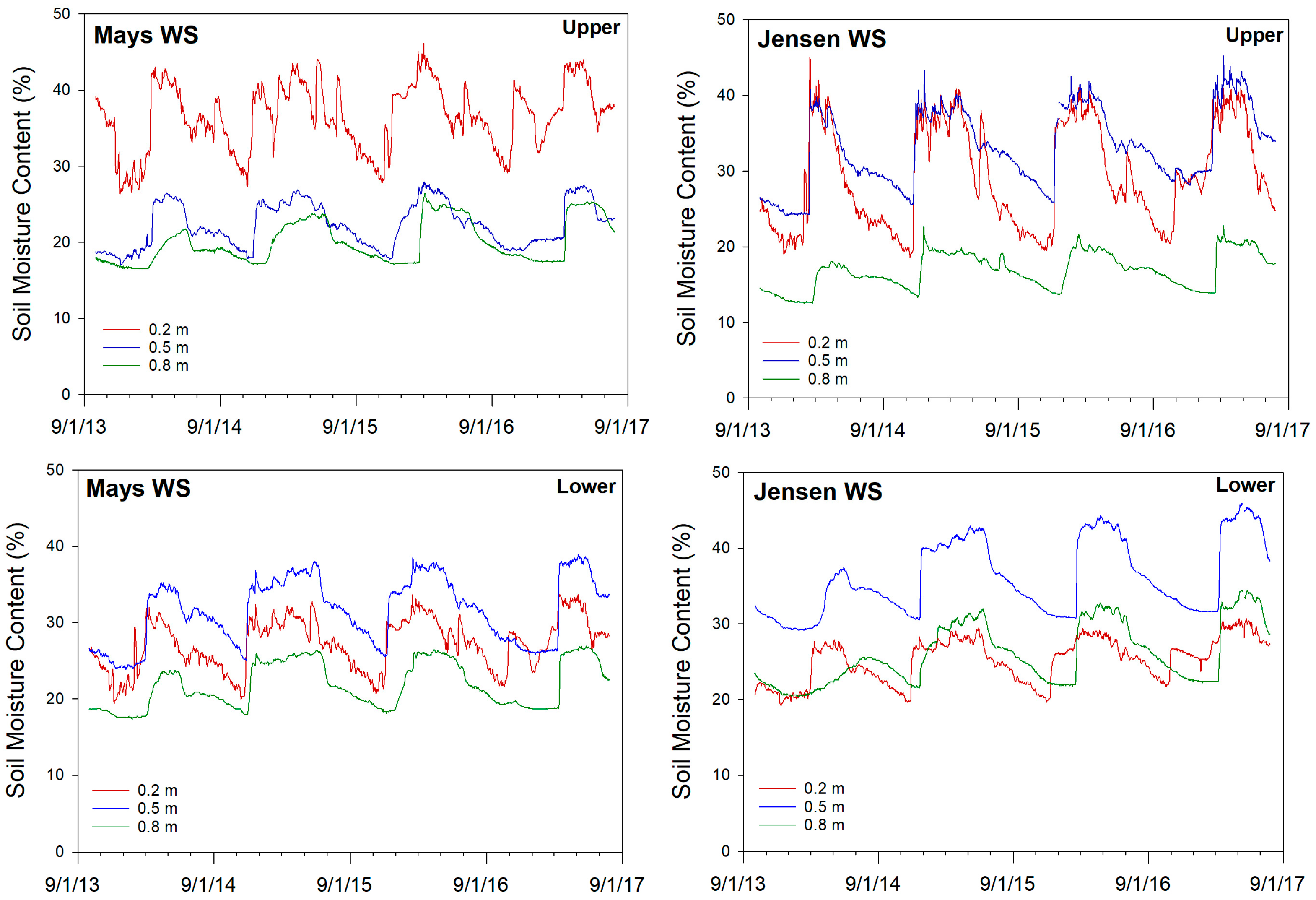
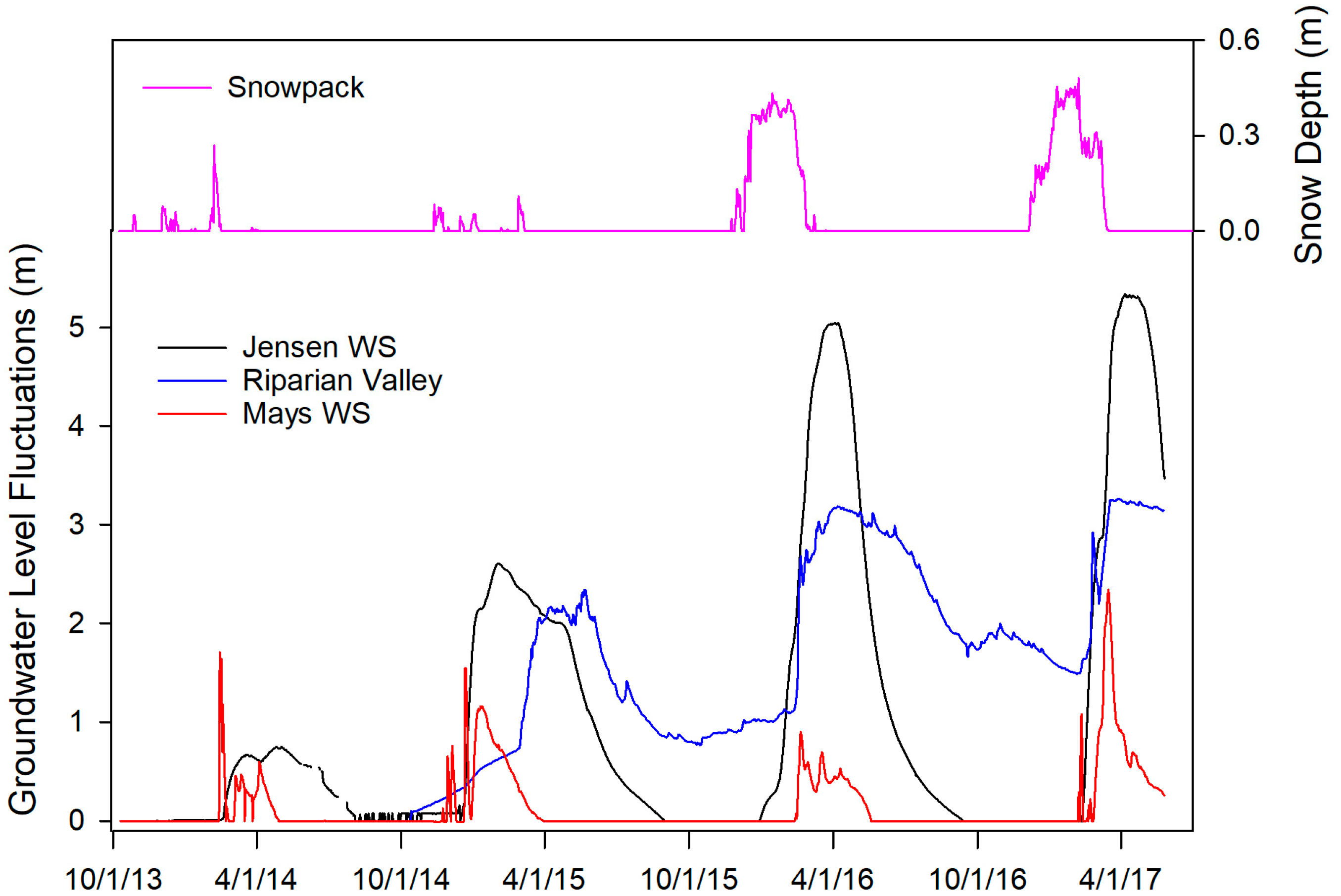
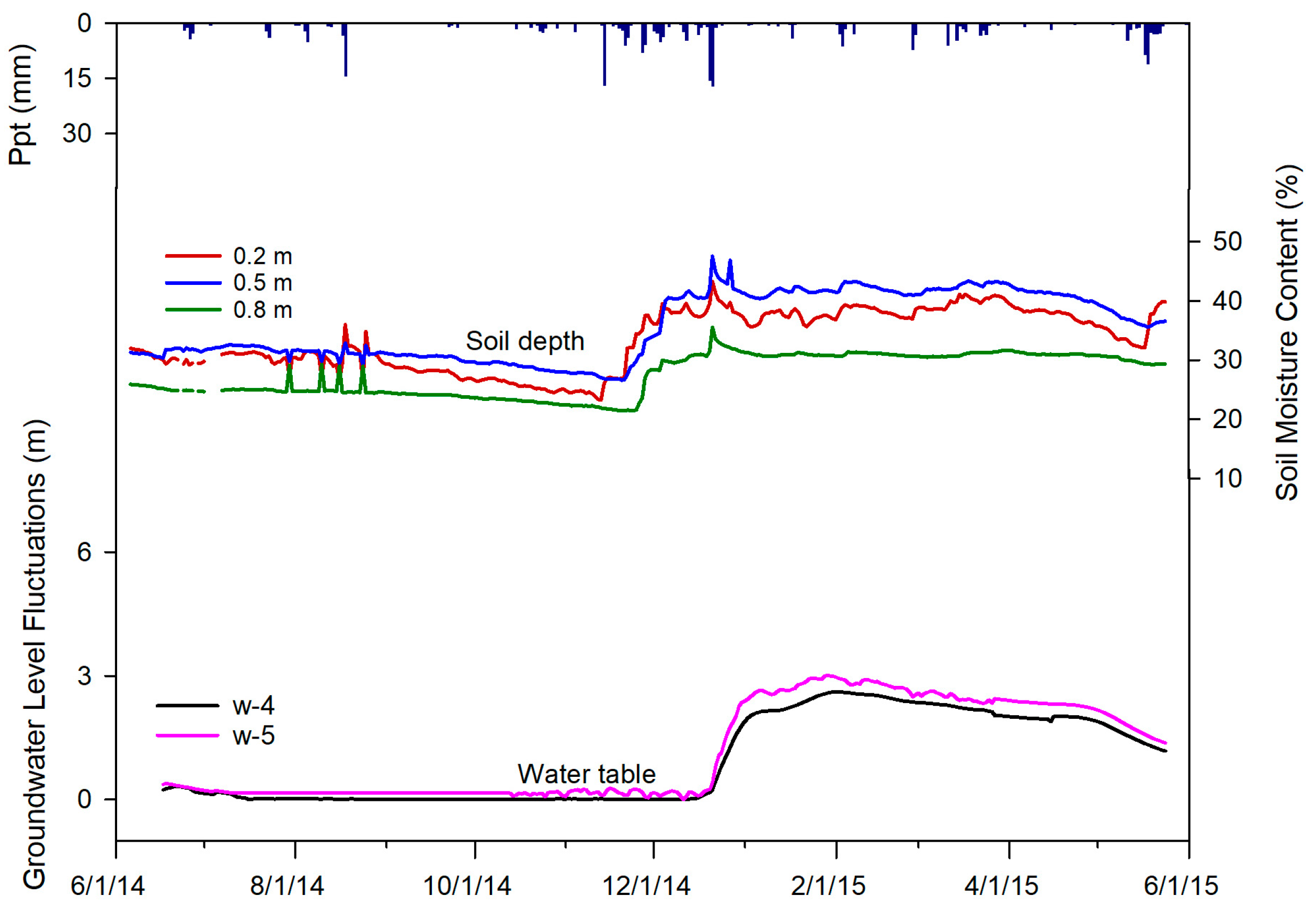

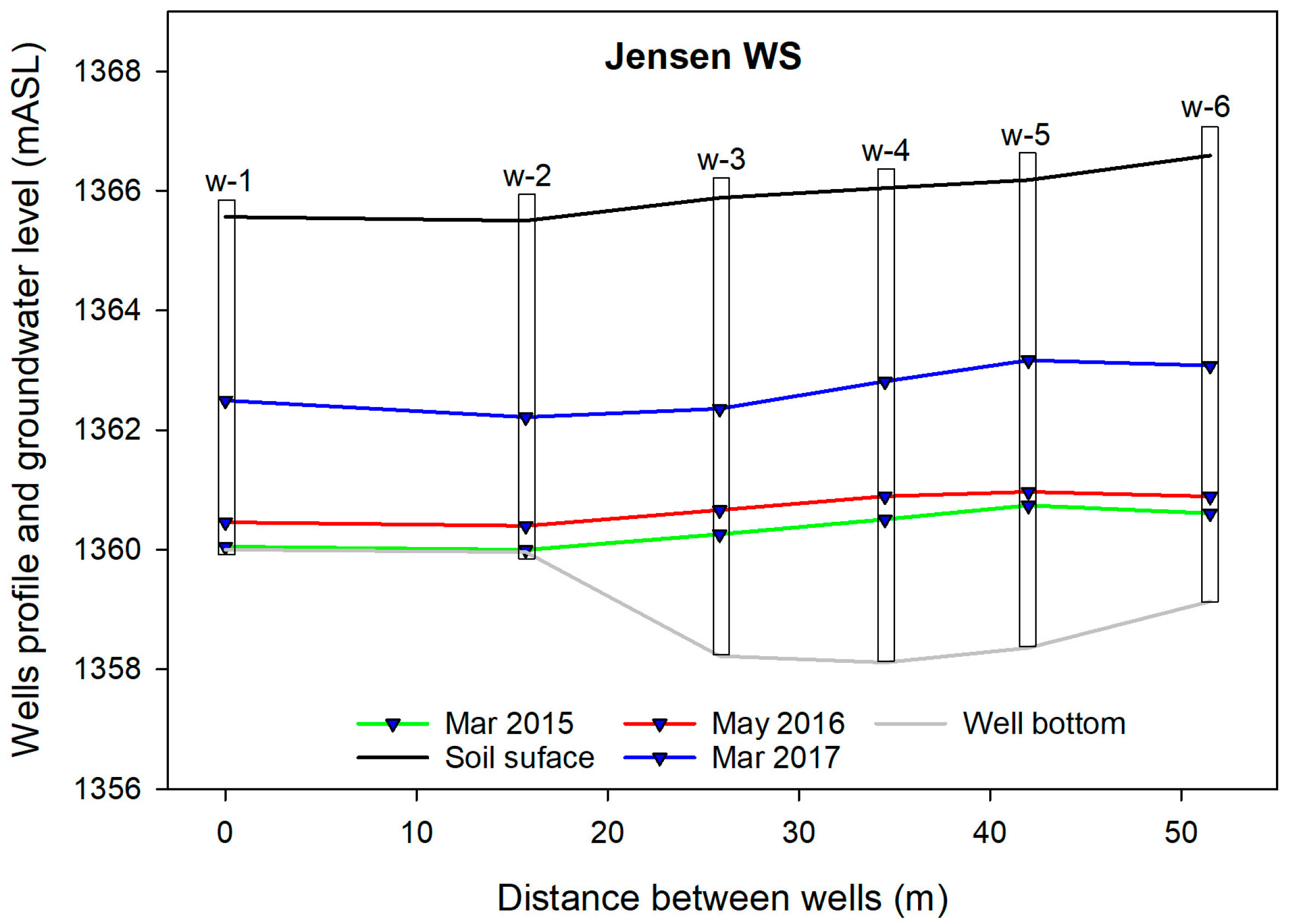
| Period of Record | P | I | I/P | Avg. IUC | Avg. IDL | Avg. IIC |
|---|---|---|---|---|---|---|
| (mm) | (mm) | (mm mm−1) | (mm) | (mm) | (mm) | |
| (a) Downstream | ||||||
| 31 October to 21 November 2015 | 24.4 | 8.2 | 0.34 | 17 ± 1.4 | 7 ± 0.1 | 0.5 ± 0.3 |
| 16 June to 17 September 2016 | 31.5 | 22.3 | 0.71 | 27 ± 2.6 | 25 ± 3.8 | 16 ± 0.2 |
| 18 September to 21 October 2016 | 34.0 | 15.0 | 0.44 | 30 ± 0.3 | 14 ± 1.5 | 0.3 ± 0.2 |
| 22 October to 10 November 2016 | 30.4 | 10.2 | 0.34 | 21 ± 1.0 | 9 ± 1.0 | 0.5 ± 0.1 |
| 11 November 2016 to 28 March 2017 | 267.4 | 123.1 | 0.46 | 191 ± 11.7 | 137 ± 3.6 | 42 ± 6.7 |
| (b) Upstream | ||||||
| 31 October to 21 November 2015 | N/A | N/A | N/A | N/A | N/A | N/A |
| 16 June to 17 September 2016 | N/A | N/A | N/A | N/A | N/A | N/A |
| 18 September to 21 October 2016 | N/A | N/A | N/A | N/A | N/A | N/A |
| 22 October to 10 November 2016 | 29.6 | 7.7 | 0.26 | 17.1 ± 3.2 | 6 ± 1.3 | 0.2 ± 0.04 |
| 11 November 2016 to 28 March 2017 | 278.0 | 127.2 | 0.46 | 192 ± 13.5 | 122 ± 8.0 | 68 ± 26.0 |
© 2018 by the authors. Licensee MDPI, Basel, Switzerland. This article is an open access article distributed under the terms and conditions of the Creative Commons Attribution (CC BY) license (http://creativecommons.org/licenses/by/4.0/).
Share and Cite
Ochoa, C.G.; Caruso, P.; Ray, G.; Deboodt, T.; Jarvis, W.T.; Guldan, S.J. Ecohydrologic Connections in Semiarid Watershed Systems of Central Oregon USA. Water 2018, 10, 181. https://doi.org/10.3390/w10020181
Ochoa CG, Caruso P, Ray G, Deboodt T, Jarvis WT, Guldan SJ. Ecohydrologic Connections in Semiarid Watershed Systems of Central Oregon USA. Water. 2018; 10(2):181. https://doi.org/10.3390/w10020181
Chicago/Turabian StyleOchoa, Carlos G., Phil Caruso, Grace Ray, Tim Deboodt, W. Todd Jarvis, and Steven J. Guldan. 2018. "Ecohydrologic Connections in Semiarid Watershed Systems of Central Oregon USA" Water 10, no. 2: 181. https://doi.org/10.3390/w10020181





